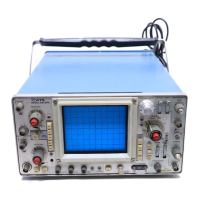TM 11-6625-2735-14-1
Installation
The following paragraphs include instructions for
unpacking, inspecting, and installing the instrument, and
the basic information required to operate the oscilloscope
within the design environmental, power, and space
limitations. (For more detailed information on specifica-
tions, refer to table 1-1.)
Unpacking.
Unpack the oscilloscope as outlined in the
following procedure:
NOTE
If storage space is available, it is recommended that
all packing material be saved for possible future use.
Thus, unpacking should be accomplished carefully
so as not to damage the packing material.
1. Open top of carton and remove styrofoam packing
case and accessory box.
2. Open styrofoam packing case and remove the
oscilloscope.
3. Open accessory box and remove accessories.
4. Remove oscilloscope from polyethylene bag.
5. Place styrofoam packing case and accessory box
inside carton. Store carton in dry place.
Checking Unpacked Equipment. Check the oscillo-
scope after unpacking.
1. Inspect the equipment for damage incurred during
shipment. If the equipment has been damaged, report the
damage on SF 364.
2. Check the equipment against the component listing
in the operator’s manual and on the packing slip to see if
the shipment is complete. Report all discrepancies in
accordance with the instructions of DA Pam 738-750. The
equipment should be placed in service even though a
minor assembly or part that does not affect proper func-
tioning is missing.
3. Check to see whether the equipment has been
modified. (Equipment which has been modified will have
the MWO number on the front panel, near the
nomenclature plate.) Check also to see whether all
currently applicable MWO’s have been applied. (Current
MWO’s applicable to the equiment are listed in
DA Pam 310-1.)
Environmental Requirements.
The following paragrahs
describe the environmental operating conditions for the
oscilloscope.
The oscilloscope can be operated where the ambient
air temperature is in the range of -28° C to +65° C, and can
be stored where the temperature range is -62° C to +75° C.
After storage at temperatures outside of the operating
ranges, allow the chassis temperature to stabilize within
the operating limits before applying power.
Oscilloscope cooling is provided by a fan drawing air
through the cabinet. Components that require the most
cooling are either mounted externally at the rear of the
cabinet on a heat radiator or are provided with individual
heatsinks. Clearance must be provided on all sides for air
flow, Do not block or restrict air flow through any holes in
the cabinet by placing objects on or against the
oscilloscope.
A thermal cutout in the oscilloscope provides
protection by interrupting power to the unit if the internal
temperature exceeds a safe operating level. Power is
automatically restored when the temperature returns to a
safe level. Operation in confined areas or near heat-
producing equipment may cause the thermal cutout to
actuate.
The normal operating position of the oscilloscope
is horizontal, setting on a flat surface, on the 4 feet
provided on the bottom surface. However, under difficult
operating conditions (such as limited space), the
oscilloscope may be used in other positions without
impairment of the electrical characteristics, including
setting the cabinet on the six protective bumpers on the
rear surface. It is important to remember that, in positions
other than the normal horizontal position, characteristics
such as cooling and resistance to shock and vibration are
altered. therefore, operation in other than the normal
position should be for short periods only and with more
than normal care exercised to protect the oscilloscope
from damage.
Power Requirements.
The oscilloscope is designed to
be operated from either a 115-volt nominal or 230-volt
nominal line voltage source. In addition, one of three
operating ranges may be selected around each nominal
Iine voltage. The voltage selector jumper on the rear panel
(figure 2-1) allows selection of the oprating voltage. With
option 07 installed, the oscilloscope may be operated from
either a 12 vdc or 24 vdc power source.
Space Requirements. The oscilloscope is provided
with feet on the bottom surface to provide space for
cooling air flow. Maintain this clearance by always setting
all four feet solidly on a flat surface. In addition, always
maintain at least 2 inches of clearance at both sides,
top, and rear of the unit.
Change 1
1-13/(1-14 blank)

